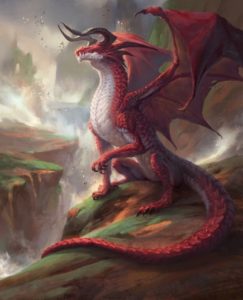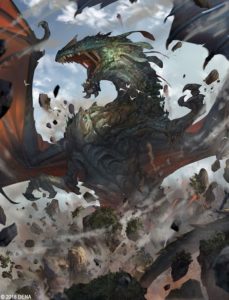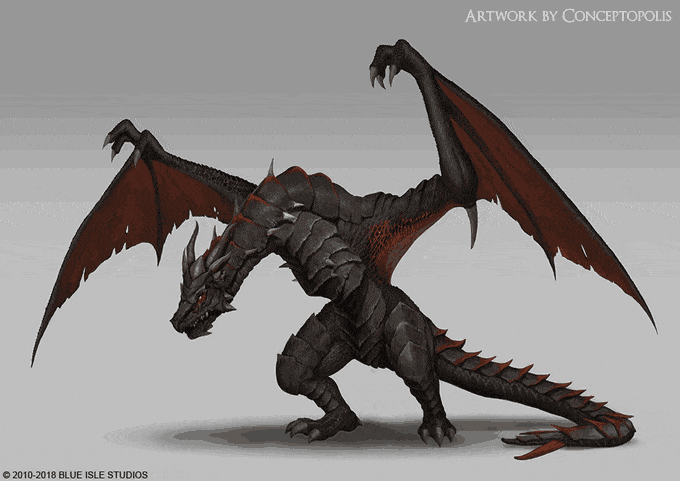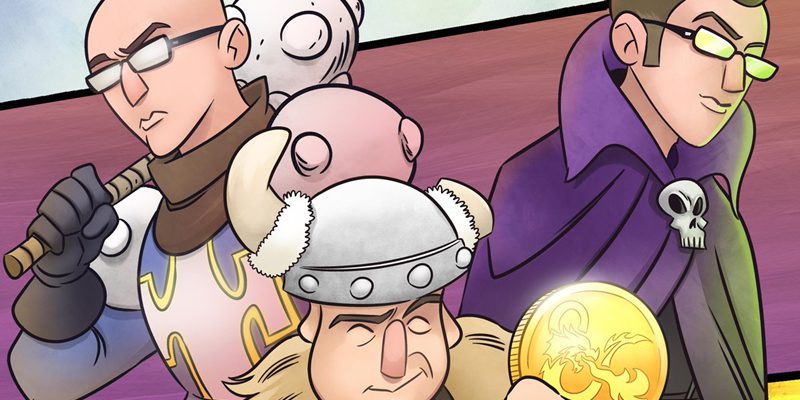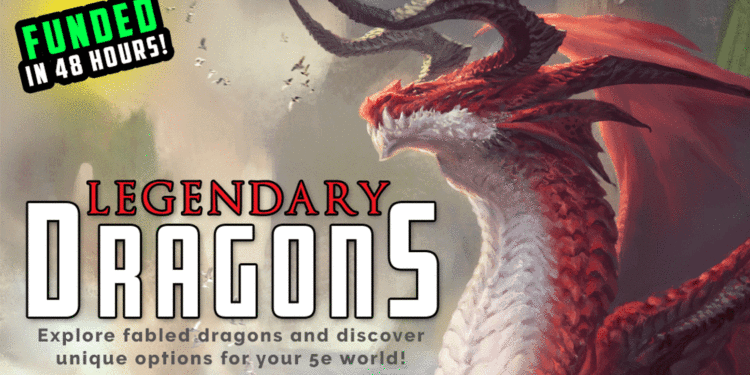
Are you bored of always using the same old dragons? Are you looking for something else to impress your players? Legendary Dragons by Jetpack7 has got some awesome monsters for you to use, as well as lots of content capable of inspiring you enough to run an entire campaign based on them. As this was not enough, the book is written by famous creators such as James J. Haeck, Dan Dillon, Cody Lewis, Jim Pinto and more!
Art
So, let’s start with the art. It has quite a bunch of full-page images in it, most of them beautiful enough to make you want to get a physical copy of the book. You can easily notice that they were created by different artists as the art style varies between the different images. Some art pieces are better than others in my opinion, but all in all, it does have some outstanding and creativity-inducing illustrations.
The second half of the book – once it went through all the Legendary Dragons – does have fewer pieces of art, which, even though they are way less impressive than those in the first set of pages, are still really good. I would have liked some other full-size image for some of those sections but can understand them not adding one.
The only single thing I will like to say I didn’t like as much of this category has not much to do with the art itself though, but with the page layout. There are some pages that have images looking out of place. Even though most images have degraded borders to make them look better, some of them were left with a clear rectangle border. In my opinion, it does make the book look less professional, but due to the content and art itself being so good I had no problem ignoring that aspect for the most part.
The Dragons
As the book has lots of different kinds of dragons I will review this specific section in parts so I can talk about all the contents in more detail:
The Legendary Dragons and Great Wyrms
What makes a dragon “legendary“? That’s what this book shows us by presenting 20 of them, each with their own tactics, lore, personality, and stat blocks, as well as their lairs. I found some better than others, as one always does. I was impressed, however, at how many of them I wanted to add to my games. The hooks and encounters provided by the book are a big help to set them up while making the job easier for you as a DM. The personality and wealth they guard give these dragons a lot of personality (I know, quite redundant) and ease to impersonate them when roleplaying. Loved the fact that not all of them are evil. One even works at an inn! Nevertheless, the icing on the cake is, in my opinion, the lore the writers provided for each of them. One can easily throw one of these dragons into their setting and gather enough inspiration to worldbuild an entire region just by giving those parts a read.
In addition to all the great content it already provides for the dragons, they obviously wrote some stat blocks for these creatures. As I said before, some are better than others, but all of them do a great job at making each feel unique in some way, as well as not distancing as much from what the creature really is. What do I mean with this? Yeah, Ilizinii, the Heart Eater can be as epic sounding as she wants, but that doesn’t stop her from having the classical dragon stat block. She just has some extra additions to it that makes her as exciting as her title, as well as some extra hit points, senses, etc. However, their breath weapons, Frightful Presence and all the other things a dragon always has, while tweaked, remains mostly the same.
The great Wyrms, on the other hand, were far less impressive. They are just buffed versions of the already existing Ancient Chromatic and Metallic dragons. Sure, they can be really useful for high tier players as enemies if they have already fought the most powerful dragons from the monster manual. I just found them a bit unnecessary. However, they don’t use much space from the book itself, and I can’t deny lots of people will find it useful. Moreover, being this book such a dragon-centric one, I believe that if there was any place to add these creatures, it is in this book.
Open Gaming Content and Drakes
This is where the creators decided to add in the dragon-kind creatures that didn’t fit in any specific category. I need to thank them for doing so, as they provided some really great creatures to use that wouldn’t reach our hands otherwise. Some of them are weird dragons not legendary enough to appear in the first section, but excellent nonetheless. The texts to describe them are more akin to the ones from the Monster Manual than the ones we were shown in this book, though, demonstrating they are one or more steps behind the great dragons from the start. I don’t find that as a bad choice but as a way of demonstrating that the creatures from this section aren’t as unique, that you can find multiple of them, in contrast to the Legendary Dragons, which are each one and unique.
Kobolds
If you are like me and have already got Volos’ Guide to Monsters, Kobold Press Tome of Beasts and Creature Codex, you have already got a huge variety of kobold to choose from. The last thing I needed was more of them. But for all who don’t own those books, these new Kobold stat blocks are really useful. What’s more, they come in with a whole ‘special units’ section. These kobolds are pretty much the SQUAD team from their army. Tactics, strategies and a bit of lore are included about this group, making them ideal to be some epic dragon’s lackeys or guards.
Dräken
Just like Lizardfolk look like a primal version of Dragonborns (even though that’s only aesthetically), the Dräken look like a way more civilized version of these creatures. Statwise, they are pretty much a Dragonborn variant. What is interesting about them, however, is not only their lore but their mutations. If you have ever played some TTRPG in the past that lets you create a mutant player character you can pretty much get an idea on how this works. Once every couple of levels you are to roll a percentile die that creates a mutation in your character’s body.
Mutations can be cosmetical, give some new ability to the character and/or some drawback. I can think of some DMs finding this race mechanic a bit powerful if the player is lucky enough, and I do agree up to a point. You see, part of the fun of this race is the fear of having a character with some extra flaw (or fun in roleplaying them) that comes in the form of a race mechanic. Worry not though, as receiving a drawback has a really slim chance of happening, while cosmetic mutations, for example, are literally what you are supposed to end up receiving half the time (50% chance).
Dragon Riders and Hunters
If you have ever read the Dragonlance books or the Eragon saga (I mean the books, not the movie, which is awful) you have pretty much got the concept of what this section of the book talks about. I was surprised to find out how greatly explained it is. It even creates a Dragon Rider class for the players to use, which I found pretty balanced. The abilities felt original, and the subclasses pretty distinct from one another. The only thing I might end up modifying a bit about the class is the dragon companion’s maneuvers, as some of them seemed too strong. Did not have a chance to playtest it yet, however, so I can’t say for sure. It’s pretty much what I would expect out of a class like this and I feel really happy with the result. Much so that it even inspired me enough to think about creating a mini-campaign with my players all being dragon riders in a world like the one the writers describe in this section.
On the other side of the spectrum, we’ve got the Dragon Hunters. These are the ones that used to hunt the dragons for sport, with the excuse that it was to protect people from their attacks. Nowadays, there aren’t as many as this sport got forbidden. Nevertheless, the few standing hunter groups have their own clans or organizations with great hunting flying vessels. Instructions to command these are laid out in the book, which, if I were you, would expand with the Of Ships and Sea Unearthed Arcana. Furthermore, it has quite a bit of lore for you to add these kinds of groups to your own game. Now I’m also wanting to create a campaign of players being dragon hunters, running from the law! There is so much good stuff it is really difficult to contain myself from not adding everything to my running campaign.
Dragon Hunting Economies
Similar to many videogames’ crafting system, especially Monster Hunter, this supplement also adds in some rules to gather dragon parts, glands and more. If you are one to let your players experiment with monster organs to create potions, weapons, etc, this is just for you. In addition, this section also provides the DM with the price for all Dragon parts, in case they want to sell them. I immediately fell in love with these charts and am definitely going to give them much use, not only for dragon parts but for other creatures too by tweaking them a bit.
The supplement also includes a section to make the dragon parts useful as spell components, improving spells in one way or another. Some end up way more powerful than others and may need some tweaking from the DM’s part. Luckily, you can easily say that one component gets consumed after being used for a spell if it ends up being too powerful. It’s not always that one fights a dragon and comes out alive, so I find that way to be a simple and effective way to balance them.
Extras
There is a whole section of the book that comes with new cults to add into your game. These come with quite a bit of lore, as well as adventure hooks. Even if you have been running a campaign for a long while and have never foreshadowed anything about this cults it should not be too difficult to drop them in if you need some extra villains. They even added some combat suggestions for them on how their team composition is, to make us the job easier.
Last but not least, they decided to add some new Magic Items. Everyone loves magic items, especially when they are game-changing. Most of the ones listed in this book are pretty powerful, but not as much as to make you feel there is no way your players should get hold of one of them. These make for excellent items to drop in the dragons’ loot piles, or for dragon hunters to wield or wear.
Here’s a link to pre-order this book.

